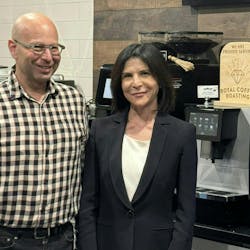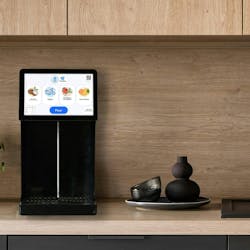In today's environment, operators are fighting many outside threats for that work-day dollar. That has led to many transforming traditional services to better meet the needs and wants of locations and the employees that those companies are trying to impress. According to our latest State of the Office Coffee Service industry report, two of these evolving services are pantry service and premium, single-cup coffee options.
Pantry service
This past year has been great for operators who are offering to stock break rooms with food and beverages paid for by the location and offered free to employees, often called pantry service or micro kitchen. Operators reported it in the top three of revenue generating services in 2016/2017 in our state of OCS report. When broken out, it was only accounting for 8.6 percent of revenues, but right above it, in the second largest share of revenue was soft drinks and juices, which could also be included in pantry, driving the percentage upward another 11 percent of sales. That was right behind coffee which represented 39.8 percent of revenues.
Why is pantry service growing so quickly? Because as Millennials move up in the workforce, they are asking for more on-site benefits and companies are starting to listen. The growing economy is also helping and these expanding businesses are willing to invest in benefits that attract and retain employees. Operators are being asked to provide food and snacks to locations that will be offered to employees for free, regularly restock kitchens, offer brewers and hot beverage machines that recreate a cafe experience and add the ancillary items that really transform a break room into a social, inspiring place that creates an alluring company culture. It has also been an answer for companies who want to save money on cafeterias, but still have the budget and employee numbers to support offering convenient food and specialty drinks onsite instead of having employees leave the workplace to get them.
Single-cup grows
Both decisions makers and employees love the idea of single-cup — coffee made one cup at a time from a countertop brewer. It represents coffee that is personalized in an environment where there wasn't the ability to make personalized coffee previously. It also remains somewhat of a novelty, especially when premium beans are used or the equipment has a more sophisticated level of interaction, such as a touchscreen that allows users to create their own recipes.
Single-cup, in all its forms, attracted consumers even more so in 2016/2017, despite the higher price per cup it carries. A majority, 64.1 percent of OCS providers reported that they have increased the number of single-cup equipment they provide. Single-cup brewers are now nearing 20 percent of the total placed brewers by type, a number they were reaching towards about 5 years ago when concerns about quality and value flattened single-cup sales.
Brewers seeing the most growth
K-Cups and Keurig brewers are still strong contenders in the marketplace. However, some operators struggle with pricing as K-Cups as available nearly everywhere, putting pressure on margins.
Other single-cup options are also on the rise. Pod brewers, specifically have experienced a resurgence in terms of market share with more being placed. However, the most popular single-cup brewer this year, according to survey responses, was the bean-to cup brewer. It grinds whole beans. It brews espresso. It makes lattes. Bean-to cups have a lot going for them. They are even versatile, allowing any type of coffee to be used from national brands to local roasts.
Locally roasted coffees are of special interest to certain locations. These are the roasters that maybe have one café or tasting room and build a reputation in the area. Customers are willing to pay extra for these small batch or artisan lines.
Bean-to-cup offers versatility, costs
Because the bean-to-cup machine is filled with whole beans, there are more options, and no packaging costs. The trade-off is in the cost of the brewer and additional maintenance. Most operators consider their relationship with the customer before placing a bean-to-cup brewer. For example, someone on-location must be designated to refill the hopper with coffee and clean the grinder. There is also cleaning which needs to be done, such as flushing of the equipment on a regular basis because most also offer solubles to make specialty drinks.
Now days, premium service is the new normal, so is a need to evolve and offer things that elevate the break area. One of the most important elements is coffee as most of the workforce has grown up living and working in coffeeshops and on gourmet coffee. Luckily, it is something the industry is well placed to offer to customers.





